sisco digital display controller can be used for various sensors and transmitters, such as temperature sensor, pressure sensor, flow sensor, level sensor, displacement sensor, AC/DC current sensor, transmitter with 4-20mA/0-5V output, etc. This digital panel meter has double 4 digit LED for PV and SV display.
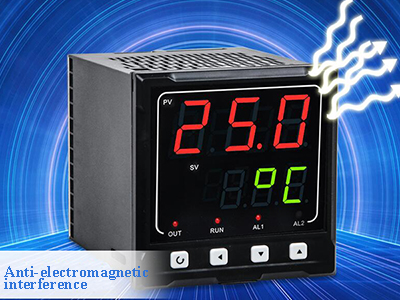
Strong anti-interference ability
sisco digital panel meter adopts advanced isolation technology. Its signal is still stable under strong electromagnetic interference conditions.
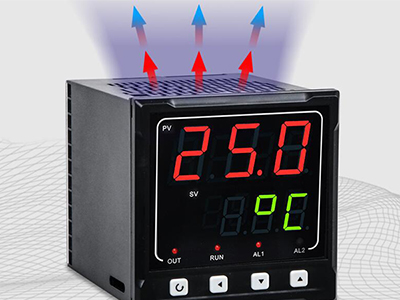
Stable operation at high temperature
In high temperature closed occasions, 4 digit digital panel meter can effectively dissipate heat, refuse temperature drift, and operate stably.
Applications
Double 4 digit digital panel meter can be applied to many occasions, including petrochemical, mechanical shipbuilding, plastic machinery, light industry machinery, chemical, metallurgy, electricity manufacturing, food, medicine, etc.

| Basics | Model | SISCO-DPM-USD4D-1100 |
| Dimension (W*H*L) * | A: 160*80*110mm horizontal, hole size 152*76mm B: 80*160*110mm vertical, hole size 76*152mm C: 96*96*110mm, 92*92mm D: 96*48*110mm horizontal, hole size 92*45mm E: 48*96*110mm vertical, hole size 45*92mm F: 72*72*110mm, hole size 68*68mm H: 48*48*110mm, hole size 45*45mm |
|
| Shipping weight | 2 kg | |
| Technical parameters | Display range | -1999~1999 |
| Measurement accuracy | 0.3%FS | |
| Display method | One channel double 4 digit LED display (PV and SV) | |
| Input signal * | Thermocouple, RTD, linear resistance, presssure sensor, level sensor, current sensor, voltage sensor, analog signal, etc. (See details in the selection chart.) | |
| Output signal * | A0: No output A1: 4-20mA (RL≤600Ω) A2: 1-5V (RL≥250KΩ) A3: 0-10mA (RL≤1.2KΩ) A4: 0-5V (RL≥250KΩ) A5: 0-20mA (RL≤600Ω) A6: 0-10V (RL≥4KΩ) T: RS485/232 (Modbus) |
|
| Alarm mode* | R0: No alarm output R1: 1 alarm relay R2: 2 alarm relays Note: 1 alarm relay includes: NO (AC 220V/3A, DC 30V/5A), 2 alarm relays include: NO+NO (AC 220V/3A, DC 30V/5A). When choosing the dimension H (48*48*110mm), the relay capacity is AC 220V/0.6A, DC 30V/0.6A. |
|
| Additional power supply * | P0: No power supply P1: DC 24V, <30mA Note: Additional power supply can provide DC power supply for other devices such as sensors. |
|
| Meter power supply * | A: AC 100-240V, 50/60Hz D: DC 20-29V |
|
| Power dissipation | ≤5W | |
| Temperature drift | 0.2%FS/year | |
| Shell material | ABS | |
| Isolation method | Isolation between input, output and power supply | |
| Environment temperature | Temperature0~50℃ (32~122℉), humidity≤85%RH (no condensation) |
Input signal selection chart
| Number | Signal | Parameter code | Range | Number | Signal | Parameter code | Range |
| 0 | B type | T--B | 400~1800℃ | 17 | 0-500Ω | R0.5K | Full range |
| 1 | S type | T--S | 0~1600℃ | 18 | 0-350Ω | 0350 | Full range |
| 2 | K type | T--K | 0~1300℃ | 19 | 30-350Ω | 3350 | Full range |
| 3 | E type | T--E | 0~1000℃ | 20 | 0-20mV | 20MV | Full range |
| 4 | T type | T--T | -200.0~+400.0℃ | 21 | 0-40mV | 40MV | Full range |
| 5 | J type | T--J | 0~1200℃ | 22 | 0-100mV | 100M | Full range |
| 6 | R type | T--R | 0~1600℃ | 25 | 0-20mA | 20MA | Full range |
| 7 | N tyep | T--N | 0~1300℃ | 26 | 0-10mA | 10MA | Full range |
| 8 | F2 | T-F2 | 700~2000℃ | 27 | 4-20mA | 4-20 | Full range |
| 9 | Wre3-25 | T-L3 | 0~2300℃ | 28 | 0-5V | 0-5V | Full range |
| 10 | Wre5-26 | T-L5 | 0~2300℃ | 29 | 1-5V | 1-5V | Full range |
| 11 | Cu50 | Cu50 | -50.0~+150.0℃ | 31 | 0-10V | 10V | Full range |
| 12 | Cu53 | Cu53 | -50.0~+150.0℃ | 32 | (0-10mA)^0.5 | 10MA. | Full range |
| 13 | Cu100 | C100 | -50.0~+150.0℃ | 33 | (4-20mA)^0.5 | 20MA. | Full range |
| 14 | Pt100 | P100 | -200.0~+650℃ | 34 | (0-5V)^0.5 | 0-5V. | Full range |
| 15 | BA1 | BA1 | -200.0~+600℃ | 35 | (1-5V)^0.5 | 1-5V. | Full range |
| 16 | BA2 | BA2 | -200.0~+600℃ | - | - | - | - |
Wiring Diagram
1. The wiring for dimension A/B/C/D/E
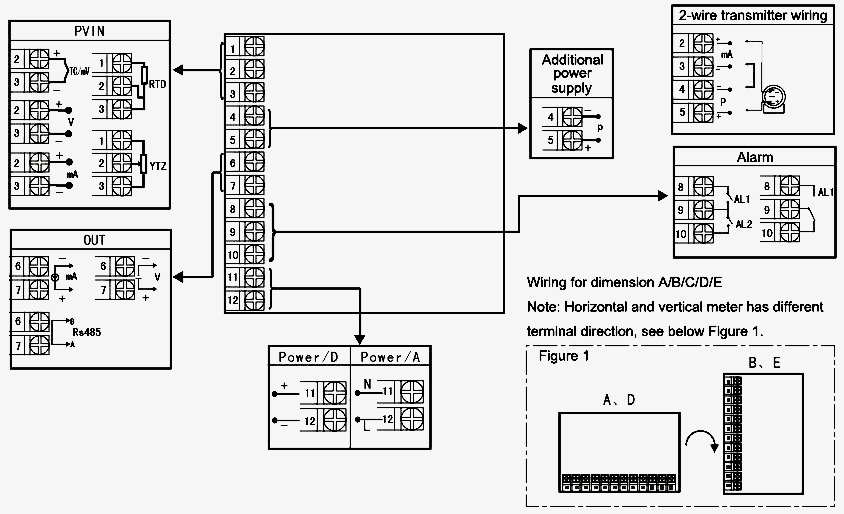
2. The wiring for dimension F
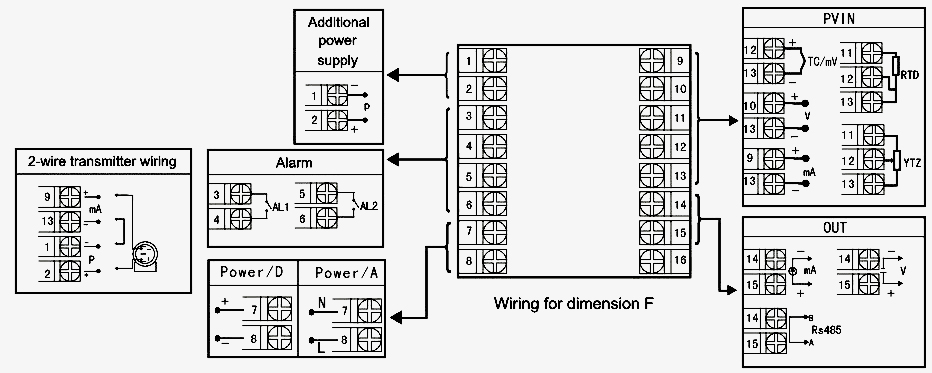
3. The wiring for dimension H
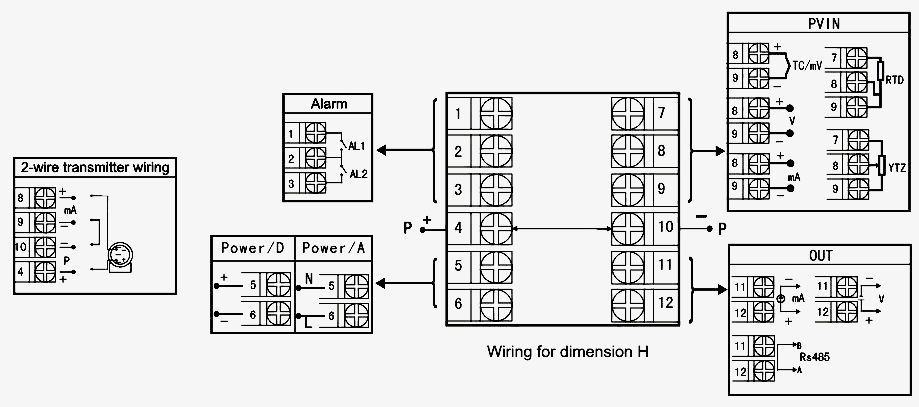
Q1: What is a digital panel meter?
A1: The digital panel meter displays the voltage, current value or other standard signal transmission display value in the electrical circuit by digital direct reading; the product has the advantages of good stability, strong anti-interference, high cost performance, and the product is small in size and can be directly replaced original pointer meter.
Q2: What are the functions of digital panel meters?
A2: Digital panel meters can be categorized by type, size, style or other criteria. Understanding the functions of the digital panel meter is an important factor in choosing it. Commonly used functions are ammeters, voltmeters, frequency meters, power meters, energy meters, counters, timers, thermometers, process meters and controllers.
Q3: What are the advantages of digital panel meters?
A3: The digital panel meter directly displays the measured value or deviation value by digital quantity, which is clear and intuitive, easy to read, and will not produce parallax. Digital panel meters generally use large and medium-scale integrated circuits, with simple circuits, good reliability and good shock resistance. Because of the common modular design method for instruments, that is, digital panel meters are mostly composed of a small number of modular circuits with separated functions, so they are conducive to manufacturing, debugging and maintenance.
Tips: How to choose a right digital panel meter?
First of all, you need to decide the function of the digital panel meter you want, and then choose according to your needs.
The basic function of all digital panel meters is to convert an input signal into a displayed value. The control panel provides power to the device and inputs required for the meter display. Inputs come from sensors in the system or process and are sent to the device through the panel to which the meter is connected. Some digital panel meters may also have optional control or interface functions: the analog function can provide an analog output proportional to the input signal (such as a variable voltage or current) for use with analog devices. The data interface function allows interaction with displayed output information for analytical use.
Thank you for buying industrial test and measurement equipment on SISCO.com, all products sold by SISCO and the partner cover a 12 months warranty, effective from the date of receiving the products.
What is covered?
SISCO is responsible for providing free spare parts, and free technical support to assist the customer to repair the defective products until the problem is solved.
What is not covered?
- Product purchased from anyone other than a SISCO store or a SISCO authorized reseller.
- Expendable parts.
- Routine cleaning or normal cosmetic and mechanical wear.
- Damage from misuse, abuse or neglect.
- Damage from use of parts other than SISCO approved.
- Damage from use outside the product’s usage or storage parameters.
- Damage from use of parts not sold by SISCO.
- Damage from modification or incorporation into other products.
- Damage from repair or replacement of warranted parts by a service provider other than a SISCO authorized service provider.
- Damage caused by the application environment not meeting the product usage requirements and the failure to perform preventive maintenance.

